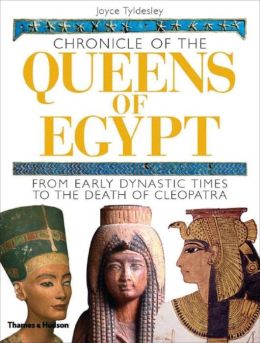Chronicle of the Queens of Egypt:
From Early Dynastic Times to the
Death of Cleopatra

Joyce Tyldesley is a British scholar, who has written several books about ancient
* Hatchepsut:
The Female Pharaoh
* Nefertiti:
Egypt
* Ramesses:
Egypt
* Cleopatra:
Last Queen of Egypt
Her book
about the queens of Egypt
Chapter 1: Dynasties 0-2. The First Queens – The Early Dynastic Period
Chapter 2: Dynasties 3-8. Queens of the Pyramid Age - The Old Kingdom
Chapter 3: Dynasties 9-17. Chaos and Rebirth – The First Intermediate Period, Middle
Kingdom and Second Intermediate Period
Chapter 4: Dynasties 18-20. Queens of the Empire – The New Kingdom
Chapter 5: Dynasties 21-31. Weakened Royal Power – The Third Intermediate Period and
Late Period
Chapter 6: The Last Queens of Egypt
At the end of the book there are notes, a chronology, a
bibliography, illustration credits and an index.
There are
273 illustrations, 173 in colour.
Today, nobody
can write a biography (in the modern sense of the word) of any Egyptian queen.
There is not enough information. In some cases we have a name, a tomb, a
portrait and maybe other items. In a few cases we have more than that. But in
many cases we have less or simply nothing. So it is not an easy job to write a
book about the queens of ancient Egypt
“For all
periods we are lacking the personal records that would really make the queens
come alive for modern readers.”
In the long
line of Egyptian queens, four persons stand out, because of who they were; because
of who their husbands (or partners) were; and because fate has given us a good
deal of historical evidence about them:
# 1 Hatshepsut (pages 94-109). [In her 1998 book about this queen, Tyldesley used an unusual spelling of the name: Hatchepsut. But in this book about all the queens, she follows the conventional English spelling: Hatshepsut.] When her husband (Thutmose II) died, her stepson (Thutmose III) was too young to rule, so she ruled in his place; first as a queen, but later as a king. She was a female pharaoh.
# 2 Nefertiti (pages 125-134). She was married to Amenhotep IV, who changed his name to Akhenaten; who changed the Egyptian religion; and who moved the capital to Amarna. The portrait of her that was found in 1912 is considered as one of the most beautiful and important works of art in the whole world.
# 3 Nefertari (pages 145-153). She was married to Ramesses II, also known as Ramesses the Great, who ruled
# 4 Cleopatra (pages 201-209). She was the last queen of the Ptolemaic dynasty. First, she teamed up with the Roman politician Gajus Julius Caesar; they had a son. After his death in 44 BC, she teamed up with another Roman politician, Mark Antony (whose Latin name is Marcus Antonius); they had three children.
Tyldesley
seems to be very familiar with Egyptian history, but there is a mistake on page
199 where she writes:
“After the death of Ptolemy IX in 62 BC, the widowed
Berenice III took her father’s throne.”
The year (62 BC) is
wrong. Berenice III was married three times: the first time to her uncle
Ptolemy X (who died in 88 BC); the second time to her father Ptolemy IX (who
died in 88); the third time to her stepson Ptolemy XI (who was killed in 80 BC
a few days after he had killed his wife). No king named Ptolemy died in 62 BC.
Certainly, Berenice III did not do anything in that year: she had been dead for
18 years. Everything else in this book seems to be correct. Therefore this
mistake is all the more perplexing.
The Italian
Egyptologist Rosanna Pirelli has written a book about the same topic: The Queens of Ancient Egypt.
Pirelli’s
book was published by White Star in 2008, while Tyldesley’s book was published
by Thames & Hudson in 2006. It is natural to compare the two books with
each other.
The book
from White Star is almost twice as big as the book from Thames & Hudson (27
x 37 cm against 27 x 20 cm ), and it is longer (272 against 224
pages). But I cannot say that one book is better than the other.
Inevitably,
many motives (illustrations) can be found in both books. For reasons of space,
I will mention only a few cases here:
* The
statue of Menkaure and his wife Khamerernebty II; today in the Boston Museum of
Fine Arts.
* The
alabaster statue of Ankhnespepi II and her son Pepi II; today in the Brooklyn Museum
* The back
panel of “the Golden Throne” showing Tutankhamun sitting and his wife
Ankhesenamun standing; today in the Egyptian Museum in Cairo.
Tyldesley’s
chronicle of the queens of ancient Egypt Egypt
No comments:
Post a Comment